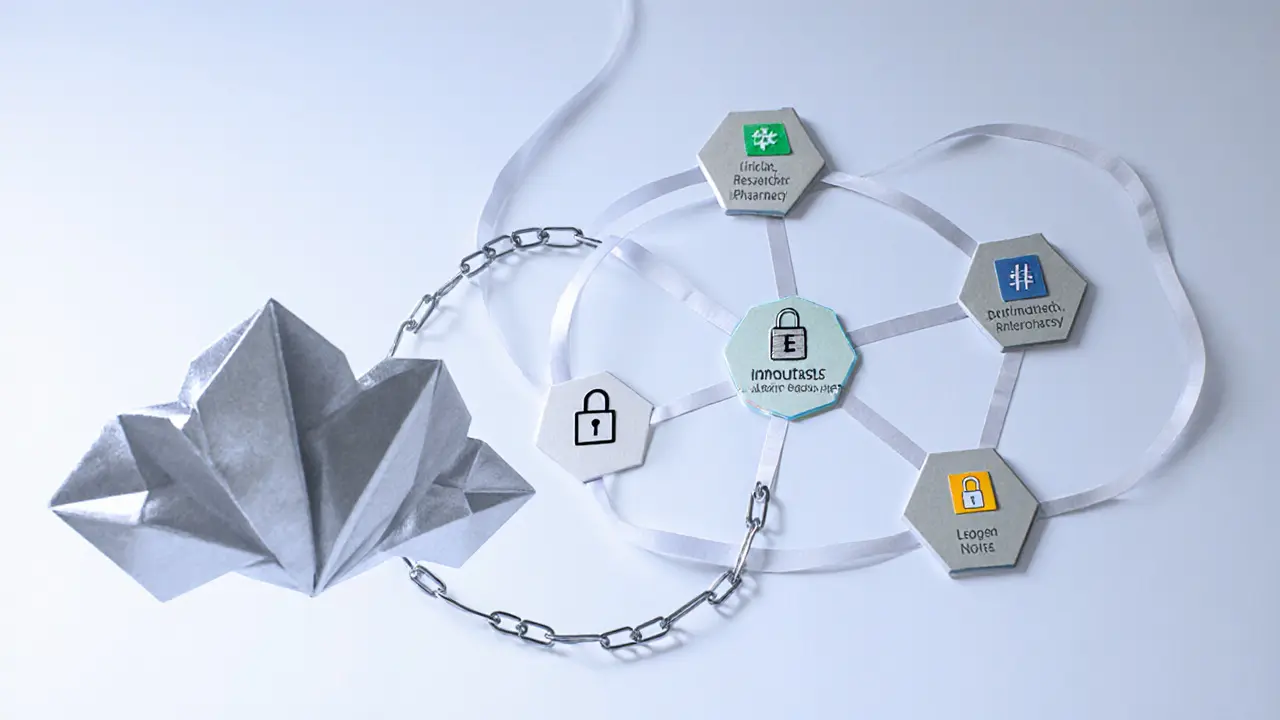HIPAA Compliance Checker
Enter your configuration details and click "Check HIPAA Compliance" to evaluate your blockchain setup.
Ever wonder if the buzz around blockchain can actually help hospitals stay on the right side of HIPAA? The short answer is yes-if you design the system the right way. This guide walks you through what HIPAA demands, how blockchain’s core features line up, and the practical steps you need to build a compliant, secure ledger for patient data.
Key Takeaways
- HIPAA’s three safeguard categories (administrative, technical, physical) map cleanly onto blockchain’s immutability, cryptographic hashing, and role‑based access controls-when you keep PHI off‑chain.
- A hybrid on‑chain/off‑chain architecture is the de‑facto standard: store encrypted PHI in a HIPAA‑approved cloud, write only hashes and pointers to the ledger.
- Permissioned blockchains, not public ones, satisfy the “minimum necessary” rule and the need for Business Associate Agreements (BAAs).
- Smart contracts can automate consent and claims, but they must never expose raw PHI.
- Regular third‑party audits, key‑rotation policies, and disaster‑recovery drills keep the system compliant over time.
What HIPAA Actually Requires
HIPAA is a federal law that sets administrative, technical, and physical safeguards for protecting Protected Health Information (PHI). The rulebook includes:
- Access Control: only authorized users may view PHI, and they must be limited to the minimum necessary.
- Audit Controls: every access or modification must be logged with a timestamp and user ID.
- Integrity: PHI cannot be altered or destroyed without an authorized, recorded change.
- Transmission Security: data in motion must be encrypted (TLS/SSL, VPN).
- Encryption at Rest: stored PHI must be unreadable without the proper key.
Violations can trigger fines of up to $50,000 per record and criminal penalties, so the stakes are high.
Blockchain Basics You Need to Know
Blockchain is a distributed ledger that records transactions as immutable blocks linked by cryptographic hashes. Its core properties include:
- Decentralization - no single point of failure.
- Immutability - once a block is sealed, its data cannot be altered without breaking the chain.
- Transparency - every participant can see the transaction history, though data can be encrypted.
- Consensus - network members agree on the state of the ledger.
Public blockchains (Bitcoin, Ethereum) broadcast every transaction to anyone on the internet. For HIPAA, a Permissioned Blockchain restricts participation to vetted entities and enforces role‑based permissions is the only safe choice.
Mapping HIPAA Safeguards to Blockchain Features
The table below shows where blockchain naturally satisfies HIPAA, and where you must add extra controls.
| HIPAA Safeguard | Blockchain Feature | Additional Controls Needed |
|---|---|---|
| Access Control | Permissioned network with role‑based access | Enforce Minimum Necessary, integrate with IAM |
| Audit Controls | Immutable, timestamped ledger entries | Secure log retention, periodic review |
| Integrity | Cryptographic hashing guarantees tamper‑evidence | Off‑chain backup of original data |
| Transmission Security | TLS/SSL for all node communication | VPN tunnels for EHR‑ledger sync |
| Encryption at Rest | Data stored off‑chain in encrypted cloud | Key‑rotation policy, hardware security modules |

Architectural Blueprint for a HIPAA‑Compliant Blockchain
The safest design follows a hybrid model:
- Off‑chain PHI Store: Use a HIPAA‑certified cloud (e.g., Azure Government, AWS GovCloud) to keep encrypted patient records.
- On‑chain Pointer Layer: Store a cryptographic hash of each record plus a URI that points to the off‑chain location. The hash proves the record hasn’t been altered.
- Permissioned Network: Deploy Hyperledger Fabric or Quorum, configure Membership Service Provider (MSP) to grant roles such as clinician, researcher, pharmacy.
- Smart Contracts for Consent: Write contracts that check a patient’s consent flag before returning the pointer. The contract never carries the raw PHI.
- Key Management Service (KMS): Centralize encryption keys, rotate them quarterly, and audit all key access events.
- Business Associate Agreements (BAAs): Ensure every blockchain vendor signs a BAA; treat the vendor as a covered entity’s business associate.
Figure‑out where each component lives in your existing IT landscape and draw a data‑flow diagram before you start coding.
Real‑World Use Cases That Benefit from a Secure Ledger
Patient Data Management creates a single source of truth for medical histories, lab results, and imaging across providers while maintaining HIPAA‑level privacy.
- Clinical Trials: Immutable trial logs reduce fraud; researchers can verify data provenance without seeing raw PHI.
- Supply Chain Tracking: Each drug batch gets a blockchain ID, enabling pharmacists to verify authenticity and trace recalls.
- Claims & Billing: Smart contracts auto‑validate service codes, flag anomalies, and settle payments in seconds.
- Consent Management: Patients sign a digital consent that a smart contract enforces, giving them real‑time control over who accesses their records.
Implementation Hurdles and How to Overcome Them
Even with a perfect design, you’ll hit snags:
- Scalability: Block times and storage can bottleneck high‑volume EHR writes. Mitigate by batching hashes and using side‑chains for less‑critical events.
- Regulatory Uncertainty: State privacy laws (e.g., CaliforniaCCPA, New YorkSHIELD) may require extra consent steps. Build a policy engine that can toggle rules per jurisdiction.
- Interoperability: Most EHRs speak HL7 FHIR. Use FHIR adapters that translate record updates into blockchain hash submissions.
- Business Associate Risk: Vendors that host the node infrastructure become BAAs. Conduct third‑party HIPAA assessments before onboarding.
- Disaster Recovery: A ledger can survive node loss, but the off‑chain PHI store needs regular backups that also meet HIPAA’s availability requirement.
Best‑Practice Checklist for a HIPAA‑Ready Blockchain
- Choose a permissioned platform (Hyperledger Fabric, Quorum, Corda).
- Keep PHI off‑chain and store only encrypted hashes on the ledger.
- Encrypt data at rest and in transit using AES‑256 and TLS1.3.
- Implement role‑based access controls that enforce the Minimum Necessary rule.
- Sign BAAs with every blockchain service provider.
- Rotate encryption keys every 90days; log all key‑access events.
- Run quarterly HIPAA audits by a certified security officer.
- Document a disaster‑recovery plan that restores both the ledger and the off‑chain store within the required RTO/RPO.
Frequently Asked Questions
Can I put patient records directly on a public blockchain?
No. Public chains are visible to anyone, and HIPAA forbids exposing PHI without encryption. Even with strong encryption, the immutable nature of a public ledger makes key‑compromise a permanent breach. Use a permissioned network and store raw data off‑chain.
Do smart contracts count as PHI?
Only if they contain actual health information. The safe practice is to let contracts reference encrypted IDs or hashes, never the underlying clinical data.
What happens if a node in my permissioned network is hacked?
Because the ledger is replicated, a single compromised node does not alter the chain. However, you must revoke the node’s certificates, rotate keys, and run a forensic audit to confirm no unauthorized transactions were injected.
Do I still need a Business Associate Agreement with a blockchain vendor?
Yes. If the vendor hosts the ledger, processes hashes, or manages encryption keys on your behalf, they are a business associate under HIPAA and a BAA is mandatory.
How can I prove compliance during an OCR audit?
Provide the audit logs from the blockchain (immutable timestamps), encryption key‑management reports, BAA copies, and the results of your latest third‑party HIPAA assessment. The ledger itself serves as a tamper‑proof evidence trail.

Next Steps for Your Organization
1. Assess your current EHR integration points and identify data that could benefit from a blockchain hash.
2. Pick a platform-most healthcare pilots start with Hyperledger Fabric because its modular architecture fits HIPAA’s role‑based needs.
3. Engage a HIPAA consultant early to draft BAAs and design the key‑management workflow.
4. Run a pilot on a single department (e.g., radiology) and measure latency, audit‑log completeness, and user acceptance.
5. Scale only after a successful audit and documented remediation of any gaps.
By marrying blockchain’s technical guarantees with HIPAA’s strict safeguards, you can build a system that not only protects patients but also earns their trust. The effort pays off in reduced breach risk, smoother data sharing, and a reputation for cutting‑edge security.





C Brown
Oh great, another “miracle” tech that promises to solve all healthcare data woes while ignoring the simplest fact: HIPAA isn’t a suggestion, it’s the law. You can sprinkle AES‑256 and RBAC on a public ledger all you want, but if a single node leaks the private key you’ve just handed criminals a free buffet of PHI. The real issue isn’t the blockchain’s “immutability” – it’s the illusion that immutability equals compliance. In practice, you still need the same rigorous audits, breach‑response plans, and BAA sign‑offs that every other system demands. So before you start bragging about “trustless” ledgers, ask yourself whether you’ve actually built a HIPAA‑ready environment or just a shiny data‑store for hackers.
Nilesh Parghi
When we think about data sovereignty, blockchain offers an intriguing way to decentralize control. By moving the hash of a patient record onto a shared ledger, we create a verifiable pointer that never changes, while the actual health information can stay behind the fortified walls of a compliant cloud. This separation respects the “minimum necessary” principle, because only authorized entities can resolve the hash to real data. It also gives patients a tangible proof that their consent was recorded at a specific moment, which can be audited later without exposing the content itself.
Keith Cotterill
-Listen-, the *real* elegance of a Hyperledger Fabric network lies in its modular consensus; you can swap out Raft for BFT with the flick of a config file!!! Yet, many so‑called “blockchain” pilots forget that the underlying cryptography must be FIPS‑140‑2 approved to satisfy the OCR. In short, you cannot simply copy‑paste Ethereum contracts and expect HIPAA bliss – the legal scaffolding is far more demanding than the code. ❗️
Adeoye Emmanuel
Imagine a hospital where every lab result is stamped on a ledger the moment it’s generated. No more lost paperwork, no more “I never received that X‑ray”. The audit log becomes a story, each entry a chapter that recounts who accessed the data, when, and why. This transparency can empower clinicians to trust the system, and patients to feel their privacy is guarded by an unbreakable narrative.
CJ Williams
😂 Wow, C, you totally nailed the hype‑train vibe! But seriously, if you lock the keys in a vault and then hand the vault to everyone, you still have a problem. The blockchain can be a fantastic ledger, yet without proper key‑management it’s just a fancy nail‑in‑the‑coffin for PHI. So yes, “trustless” doesn’t mean “careless”. 🔐
Henry Mitchell IV
Key rotation every quarter is non‑negotiable.
mukund gakhreja
Sure, just slap a BAA on a node and call it compliant, why not? The auditors will love that.
Deepak Chauhan
It is a paradox that a system designed for transparency can simultaneously conceal sensitive data behind layers of encryption. The ledger reveals that a transaction occurred, yet the payload remains hidden, satisfying both regulatory scrutiny and patient privacy. This duality, dear colleagues, exemplifies the delicate balance we must achieve in modern health informatics. 😊
Aman Wasade
Ah, Keith, your warning about “copy‑paste Ethereum” is spot‑on. Still, let’s not dismiss every public chain outright – with proper permission layers, even a public network can be walled off. The key is designing the governance model so that only vetted actors can write or read PHI‑related hashes. That way, we keep the tech’s benefits without sacrificing compliance.
Kamva Ndamase
Listen up, folks! HIPAA isn’t a suggestion; it’s a steel‑clad fence, and you can’t just doodle a blockchain around it and call it a masterpiece. You need locked‑down encryption, airtight BAAs, and an audit trail that sings louder than a banshee when something goes awry. Anything less is a reckless gamble with people’s most intimate data.
bhavin thakkar
Let’s break this down step by step: first, you must classify every data element as PHI or not – a misstep here cascades into every downstream control. Second, the hash you store on‑chain must be generated using a FIPS‑approved algorithm; otherwise the whole chain is a house of cards. Third, the off‑chain storage must enforce role‑based access and encrypt at rest with AES‑256. Fourth, every node must present a valid X.509 certificate signed by a trusted CA, ensuring only authorized entities can participate. Finally, continuous monitoring and quarterly penetration testing are mandatory to keep the system alive and compliant. Miss any of these, and you’ve just opened the floodgates for a massive breach.
Thiago Rafael
Compliance is not a checkbox; it is a living organism that must be nurtured through disciplined processes and rigorous engineering. When integrating blockchain into healthcare, the first pillar is data segregation: raw PHI remains in a HIPAA‑certified cloud, while only cryptographic digests travel onto the ledger. This design satisfies the “minimum necessary” rule because the ledger never contains intelligible health information. Second, the network must be permissioned, restricting participation to vetted entities that have signed Business Associate Agreements, thereby aligning with the BAA requirement. Third, every transaction that writes a hash to the chain must be accompanied by a tamper‑evident audit log that records the user ID, timestamp, and purpose of access, fulfilling HIPAA’s audit control mandate. Fourth, encryption must be applied both in transit-using TLS 1.3 with strong cipher suites-and at rest, employing AES‑256 keys managed by a Hardware Security Module. Fifth, key management practices must include rotation every 90 days, secure storage, and split‑knowledge policies to prevent a single point of compromise. Sixth, smart contracts that mediate consent must be carefully coded to avoid embedding PHI; they should reference only encrypted identifiers and enforce consent checks before returning pointers. Seventh, the system architecture should incorporate regular third‑party assessments, including penetration testing and compliance audits, to validate that the technical safeguards remain effective over time. Eighth, disaster recovery plans must address both the ledger and the off‑chain storage, ensuring that backups are encrypted, geographically redundant, and recoverable within the required RTO/RPO windows. Ninth, governance frameworks need to define incident response procedures that trigger breach notifications within the 60‑day window stipulated by the OCR. Tenth, continuous monitoring using SIEM tools should alert on anomalous node behavior, such as unexpected certificate usage or abnormal transaction volumes. Eleventh, the organization must maintain thorough documentation of all policies, procedures, and configuration settings, because auditors will scrutinize every detail. Twelfth, staff training programs must educate clinicians and IT personnel on the proper use of the blockchain system and the importance of safeguarding credentials. Thirteenth, any integration with existing EHR systems should leverage standardized APIs, such as HL7 FHIR, to preserve interoperability without compromising security. Fourteenth, regulatory changes, such as state‑level privacy statutes, should be tracked and incorporated into the compliance roadmap to avoid inadvertent violations. Finally, senior leadership must champion the initiative, allocating resources and fostering a culture that treats compliance as a strategic advantage rather than a burdensome afterthought.
Janelle Hansford
It’s exciting to see the community experimenting with these ideas – every pilot brings us closer to a future where patients truly own their health data, and providers can share information securely without worrying about compliance headaches.
dennis shiner
Oh sure, just throw a blockchain at HIPAA and call it solved.